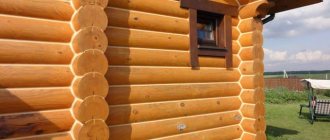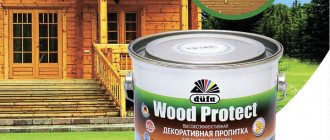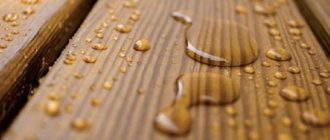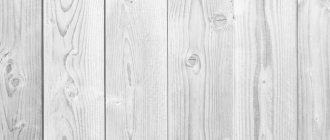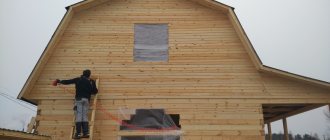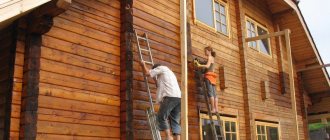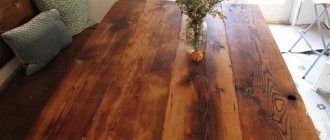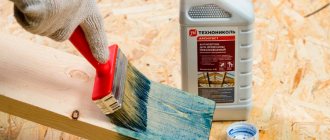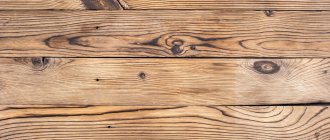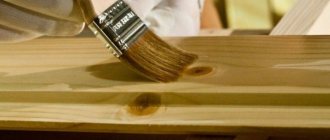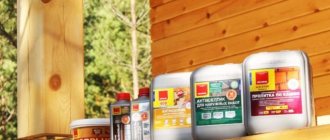When using wood as the basis for a future street fencing, it is important to provide for both preliminary processing of raw materials before fastening, and final processing, after installation of all elements.
At the finishing stage, the easiest way is to paint a wooden fence. This will be appropriate for any design, and the variety of colors allows you to please demanding customers. For those who do not want to hide the wood structure, there are antiseptics, varnishes and impregnations.
Users often search for:
- Construction of a decorative wooden fence
- Wooden fence made of unedged boards
How to treat the surface
Depending on the size of the fence and the financial capabilities of the owners, the method of painting the lumber is chosen.
Manually
The generally accepted option. The following equipment is used as equipment:
- Brush. It is in greatest demand among the population. Thanks to different thicknesses and widths when painting, it covers hard-to-reach areas. It costs little, but processing large fences takes a lot of time and effort. In addition, you need to pay attention to the quality of the brush bristles. Cheap products leave particles on the fence when painted.
- Roller. A good solution for processing tall, long fences. Provides uniform application, but paint consumption increases significantly. It does not cover certain areas, which is why you have to buy an additional brush.
Spray gun
It is also called a spray gun. Excellent for painting smooth wooden surfaces. Provides even coverage. Paint consumption is economical.
The processing process is faster than manually. To use the tool, no knowledge of special techniques is required.
The only negative is the need to purchase auxiliary equipment such as a compressor.
Updating an old fence
If you already own a wooden fence, then do not forget about timely processing, which should be carried out at least once every 2-4 years:
- First you need to carefully remove the top layers of paint with a scraper or wire brush. There are also special gels that soften old layers of paint and allow them to be removed.
- Make sure there is no damage from insects or rot. If such damage is found, remove it or replace the old boards with new ones.
- After these preparatory procedures, proceed to applying varnish or paint. The more carefully you treat the fence, the longer it will please you with its appearance and will not require large investments.
If you follow simple tips on selecting materials for the fence and processing it, the finished structure will last for many years. And following the rules of operation and maintenance will help maintain the attractive appearance of a wooden fence.
Step-by-step instructions for painting a fence with your own hands
The process consists of several stages. Let's look at each of them in detail.
Selection of tools
You will need:
- sandpaper;
- putty knife;
- wire brush (if you need to remove old paint);
- putty for wood;
- tassels (wide and narrow);
- roller;
- primer;
- rubber gloves, protective mask;
- dye.
The optimal weather for processing is clear, without wind. It is not recommended to apply in hot weather, as the product will dry quickly without creating a sufficient protective film.
Preparation
Procedure:
- We remove unevenness and roughness from the surface with sandpaper and a brush. We polish thoroughly.
- If there are noticeable chips or cracks on the wood, it is better to treat the material with a primer.
- After it is completely absorbed, cover the damaged areas with putty.
- Let the putty dry. Sand the surface again.
Painting process
In the event that the lower part of the wooden fence and the posts will come into contact with the soil in the future, to treat them you need to buy paint that contains bitumen. This component guarantees high-quality waterproofing of processed raw materials.
It is best to paint fence sections in a horizontal position, when the structure is not yet fully assembled. They are laid on a clean base made of cardboard or plywood.
The direction of the brush or roller is from top to bottom, using even strokes.
After applying the first layer, it needs to be allowed to dry. Then you can decide whether to apply a second one.
Fans of original options can:
- paint the pillars in dark colors and the sections in light colors to create contrast;
- make each picket fence a different shade;
- depict floral patterns and funny people on the surface.
If you like natural wood, then you should varnish the fence, adding carved elements to it.
Thematic material:
- DIY picket fence
- Painting a metal fence
Columns
Posts are an important element in the design of a wooden fence, so you should carefully select and process them. Choose dried timber without bark: pests can live under it. And if bark is present, the beams must be thoroughly cleaned of it and treated with a septic tank to remove insects.
The humidity of the material should not be higher than 15%. Only in this case will the result of impregnation be durable and effective. Pay attention to whether there are delaminations or mold on the posts. Even if you remove the mold and treat it with a special solution, the pole will rot.
Solutions for columns
When processing pillars, special attention must be paid to the lower part, which is in contact with the ground. It is this part of the timber that is most at risk, because it retains high humidity, which is a favorable environment for the proliferation of pests and rot. Over time, pests move throughout the post and destroy it.
Bitumen-based solutions are well suited for treating the underground part. A tree that has withstood impregnation for 1-2 days in a solution of 5-7% vitriol does not rot for about 15-20 years. Impregnation should not be carried out in foggy or rainy weather. The top of the post should be treated with varnish with an ultraviolet absorber. The varnish must be colored. A post treated with this varnish is not affected by weather conditions: rain, sun, wind. Often fence posts are painted with an oil or alkyd composition, but you need to remember that in this case the paint will hide the structure of the wood.
Treating wood surfaces in winter
If the need to protect a wooden fence arose in winter, the choice of means will be limited. Paints such as styrene-acrylic or latex are suitable. They are resistant to low temperatures.
But the order of application is somewhat unusual:
- Half of the paint is mixed right outside.
- The second part is in a warm room.
This combination of solution temperatures, according to manufacturers, ensures strong adhesion of the paintwork to wood.
Harmful effects on the fence
Wood is traditionally the most common construction and finishing material in Russia. Both the houses themselves and their fences are constructed from it. But this material is not resistant to many external influences.
Processing wooden pickets
Fence wood must be protected from the following negative factors:
- Exposure to harmful microorganisms. These are pathogenic fungi: blue, rust, green, black, white mold, as well as putrefactive bacteria. Their mycelia and colonies, growing, first change the color of the organic matter (it begins to turn black). And then rot eats it, turning it into dust. Harmful microorganisms appear due to excessive moisture in the wood. This environment is favorable for their reproduction.
- Life activity of harmful insects. Beetles - weevils, bark beetles, borers and others - destroy the tree, eating through many passages in it. Many types of insects are carriers of spores and bacteria, and therefore are capable of starting the process of decay.
- Climatic and weather conditions: wind, showers, temperature changes. In this case, wetting/drying and expansion/contraction of the material alternate. In the winter season, freezing of moistened wood is added to all this. It leads to rupture of cellulose fibers, the material begins to darken, crack and collapse. Sometimes moss appears on it.
- Solar ultraviolet radiation is also harmful to wood organic matter. It decomposes the lignin contained in it, which is a natural polymer. This substance structures the fibers, gives the wood hardness and tone. From prolonged exposure to direct sunlight, the fence fades and then acquires a grayish color. Organic matter becomes covered with numerous cracks, and its structure becomes loose. Only an opaque coating can preserve a wooden fence and protect it from ultraviolet radiation.
- Open fire. If there are buildings close to the fence, then it is advisable to cover it with fire protection. This is done by impregnation with a fire retardant.
Waterproofing of pillars
Bottom line: the main enemies of a wooden structure are atmospheric moisture, pathogenic microorganisms, ultraviolet radiation, harmful insects and fire.
If you do not protect against them, the fence will not last even 5–7 years. Treating a wooden fence will extend the life of the structure for many years.
It is also worth paying attention to the fact that harmful insects already live or appear in the wood under the intact bark, feeding on its thickness. The beetles and their larvae die in the debarked material.
Based on this, you should not store slabs and unedged boards on the street for a long time. The bark must be removed from them.
Antiseptics for treatment
Features of painting an old fence
The old fence is painted in the same way as the new one. With the exception of preparation - here it must be thorough.
Old paint is removed with a brush or metal paper. There are solvents that are applied to a rag and wiped off the dried paint. All processes are performed using rubber gloves. If some of the boards are eaten by insects, then it is better to replace them.
Old varnish is removed in the same way. The cracks are primed and puttied. Afterwards the fence is painted.
The choice of product is individual. The main condition is high-quality protection of treated wood for decades without losing its attractive appearance.
What impregnation to treat a blackened wooden fence
If the fence has stood for several years or more, and during this time it has turned black, then it must first be inspected. During inspection, carefully clean the blackened areas, removing mold, mildew, and old coating. Use tools such as a metal fiber brush or coarse sandpaper.
Unfortunately, impregnation or treatment of already destroyed, blackened wood is not able to return it to its original state - it can only slow down the process of destruction. Therefore, it is better to pay attention to preventive treatment of boards than to later waste time and effort on restoring the fence.
However, after removing the damaged structure from the boards with a wire brush, the fence is primed several times and coated with deep penetrating paints. They will help to completely close the pores of the wood and prevent further damage and blackening.
Treating the fence with glassine will give good results.
This substance was specially created to protect wood that is exposed to moisture. The composition includes antiseptics and herbicides. The mixture is applied to raw wood, debarked or freshly cleaned. The substance penetrates deeply into the pores, then the process of displacing moisture from the wood texture begins, after which its surface polymerizes and becomes closed to moisture, mold and fungi.
A fence, like any structure at home, requires attention and basic care. It is worth regularly inspecting the fence for destruction and damage, especially if the area is large.
Processing sequence
Beginner home craftsmen sometimes have a question: should they first build the fence, and then treat it with chemicals and paint, or should all this be done with the wooden parts before they are assembled. There is no clear answer here. The first option is good because it is convenient to cover the assembled structure with protective materials and paint. Advantages of the second option: the fence will not have untreated spots in hard-to-reach places and joints. Caring for wood material begins from the day it is purchased.
The sequence is:
- Remove bark from unedged boards and wooden posts. It can promote wood borers and fungal mold.
- Plan the veins of the boards. With this treatment, the pores are closed, and the wood will last longer.
- Saturate with hot tar and wrap with roofing felt that part of the pillars that will need to be buried in the ground where exposure to moisture is high.
- To eliminate the process of rotting, treat the lower ends of the boards more thoroughly, especially if they are expected to come into contact with the ground.
To treat wood, an antiseptic is used in two stages. The first impregnation is carried out after the installation of the fence is completed, and after some time it is repeated. This should be done very carefully, remembering that this material is very toxic.
Types of paints on wood
The better a wooden product is processed, the longer it lasts. However, over time, the wood panel darkens and loses its original beauty. It is almost impossible to update its faded appearance. That's when painting the fence comes in handy. To do this, you can use any facade paint, such as:
- oil;
- latex;
- acrylic;
- alkyd;
- polyurethane.
Experienced specialists consider oil paint to be the most suitable for painting a wooden fence. It is affordable, non-scarce, environmentally friendly, and penetrates well into the material. In contrast, the latex mixture dries on the surface of the wood, creating a reliable protective layer. Despite the relatively low cost, acrylic paint has remarkable qualities: resistance to moisture, and is not afraid of temperature changes and sunlight.
This is good protection for a wooden house, not just a fence. It is environmentally friendly because its solvent is water. But alkyd paint on wood gives off a pungent odor that disappears only with time. This disadvantage is compensated by its rich color, as well as high reliability in rain and frost. Polyurethane paint is the most expensive and is resistant to mechanical stress. It is durable, dries quickly, creating an attractive glossy surface, but remember that it is very toxic when applied to the fence.
But whatever the paint, you must first prepare the surface for its application. All irregularities, stains of dirt and grease are removed. A thin layer of waterproof paint is then applied to the wood to protect it from moisture. The finally dried surface is coated with primer twice. Paint the fence no earlier than 24 hours after the primer layer has completely dried.
Advantages and disadvantages of wooden fences
Despite the fact that the service life of a wooden fence is shorter than that of a brick or metal fence, it is often installed by the owners of their personal plots. This choice is due to the advantages of wooden fencing:
- Environmental friendliness of the material. Wood is a natural material that does not have any effect on the soil and does not emit harmful substances into the atmosphere.
- Wood is cheaper than brick or metal. This is an affordable material in the sense that you can easily purchase the necessary lumber for building a fence: processed, unprocessed, unedged.
- Simplicity of installation and ease of processing. You don't need any special skills or professional equipment to install a wooden fence.
Among the many advantages, one drawback should be noted: untreated wood will not last a long time, being destroyed by exposure to precipitation or insect pests. To mitigate this disadvantage, various protective impregnations are used.
Preparing for painting
If the owner decides to paint the wooden fence, then after completing the procedure with an antiseptic, a primer layer is applied to it. It will ensure strength, long service life of the paint, and protect the wood from rotting. After drying, the primer is applied again. It is irrational to cover wood with thick colored paint. The tree loses its natural attractiveness.
Therefore, it is recommended to treat wooden fences with impregnation, stain or varnish. The natural pattern remains visible and is preserved for the entire life of the fence.
Building materials stores have a large selection of varnish materials: acrylic, alkyd, polyurethane, dispersion. Any of them is suitable for covering the surface of wood, but the most environmentally friendly is acrylic-based varnish. It does not cover the wood grain, but rather emphasizes its elegance.
Compositions for treating the underground part of pillars
There are many folk methods on how and with what to treat fence posts.
Here are a few of them:
- Coating with birch tar or spruce resin (the oldest and most proven method).
- Treatment with used automobile oil (the cheapest method). The oil is applied in several layers in a heated state, thoroughly saturating all ends and cracks. 90% of the waste composition is mineral oil - a good water-repellent antiseptic. The acid salts contained in the waste kill any fungus in the wood.
- Firing and processing with bitumen. The part of the log that will be buried in the ground can be burned either over a fire or with a gas burner, creating a charred layer of several millimeters. The burned part is treated with molten tar or bitumen.
The protective layer is applied in two steps, so that each layer of bitumen impregnation can harden; it is necessary to withstand the drying period of the first layer for about a day. Bituminous impregnation is correspondingly black in color, so treat only that part of the wooden fence post that will be hidden in the ground.
It is not recommended to apply bitumen impregnation to wooden poles during fog or rain.
The construction market also offers all kinds of synthetic waterproofing compounds - mastics, pastes, etc. For example, bitumen mixtures Biom-2 or “Izhora”, several layers of which, in combination with fiberglass mesh and protective film, create excellent waterproofing with high protective properties, designed for 10-15 years of operation. Moreover, a 15-kilogram bucket of such a mixture costs only 450 rubles.
Neomid 430 eco is a preservative, non-washable antiseptic for external use, which provides maximum protection for wood during prolonged contact with soil and moisture. Protects against damage by wood-destroying and wood-staining molds, algae, mosses, and wood-boring insects for up to 35 years.
The fence is so different!
The fence can be new or old, made from treated or planed boards. The fence from the facade needs to be treated with a “beautiful” antiseptic, and on the fence of the garden you can use folk remedies. It is advisable to treat those parts of a wooden fence that only serve as protection from ill-wishers (at a dacha where you rarely visit) in such a way that it would be scary to touch.
Parts of the fence are also in different conditions: the posts are in contact with the ground, the boards are vertical, and the veins are horizontal, and water does not drain from them. For a fence on the sunny side, it is advisable to use non-fading paint, but in the shade under trees it is not necessary.
Taking into account all these requirements, it is better to choose several antiseptics and impregnations, different in composition and cost. Why pay extra?
Fire protection
Does a fence always require fire protection? Most likely, only those areas that are located next to buildings are treated with fire retardants. They usually also contain an antiseptic. Some fire retardants penetrate deep into the wood and require impregnation in baths. In everyday life, those that create a protective film on the surface and are applied with a spray or brush are used. Such a film on a wooden fence that is exposed to adverse effects will not last long.
When working with antiseptics, tar and oil, follow safety precautions, work in a respirator and gloves. Remember, paints and varnishes are fire hazards.
When building fences, homeowners often choose wood. This is a very aesthetic building material, although its service life is not as long as, for example, a brick fence, metal profile or chain-link fence. The owner is faced with the question of how to treat a wooden fence and extend its useful life. Proper wood processing allows you not only to protect against the destructive forces of nature and wood pests, but also to make it even more attractive.
Wooden fence treated with special means
Popularity
wooden fences
explained by the properties of wood. This material:
- inexpensive;
- easily amenable to manual processing;
- does not require special skills when installing a fence;
- non-scarce;
- in the decorative design of fences it is perfectly combined with other building materials;
- provides a wide range of design options;
- is perfect not only for wooden buildings, but also for houses made of other building materials.
The first signs of rot in the boards
There are many types of putrefactive fungi: Stereum, Daedalea, Polyporus, Lenzites, Fomes and hundreds of others; the appearance is not so important, especially since the treatment of fence boards against rotting is the same.
However, all fungi can be roughly divided into three types, based on the type of decay they cause:
- white rot, the main symptom of which is the appearance of yellow, gray or white stains on the wooden surface, which gradually soften it, making it wet and fibrous;
- brown (brown) rot - because of it, the wood begins to chip and crumble, turning into unusable dust;
- soft rot is typical for damp conditions: in the house it attacks bathrooms, saunas and kitchens, fences - in places adjacent to wet soil, for example, in the shade.
Signs of rot are a change in surface color, the appearance of cracks, destruction of the structure and a decrease in strength.
There are several stages of destruction:
- initial, which is characterized by a change in color without a change in structure: the fungus does not affect the shell;
- developed, with which pits, scratches, and cracks appear in the surface;
- final, with final destruction of the structure and disintegration of wood
At the initial stage, it is still possible to stop the destruction on your own; further stages require deep impregnation in industrial conditions: the boards are placed in special baths and allowed to acidify. In this case, we are not talking about how to treat a wooden fence, but about what and when to replace it with - it will be cheaper and more durable.
Wood rots more strongly at air humidity of 75-100%, large temperature changes and when the boards are not dried enough, their moisture exceeds 15%. If the latter can be dealt with by purchasing from trusted suppliers, then the first two points cannot be dealt with. In the changeable and humid climate of central Russia, wooden fences always run the risk of becoming infected with fungus and quickly becoming unusable.
Therefore, careful and regular treatment of posts to prevent rotting is something that every owner of a wooden fence should take care of.
Popular antiseptics
The domestic building materials market is simply inundated with antiseptic compounds from different manufacturers. Here is a list of the most popular impregnations that are commonly used.
"Senezh". This material can be used both for primary processing and for wood that has already been previously treated with a different composition. The impregnation easily copes with various biodegraders and is mainly used in interior spaces. It cannot be used if the wood has been coated with paint or varnish, so all surfaces must be completely cleaned before treatment.
"Pinotex". This brand has a wide range of products, which includes impregnations for both exterior and interior woodwork, used both as primers and as a decorative coating. The manufacturer offers a transparent ready-made composition, into which you just need to add pigment. After which it can be used on wood not only as a protective layer from moisture and decay, but also as a decoration.
"Tikkurila". The Finnish manufacturer has ensured that its antiseptics not only protect wooden products and lumber from the harmful effects of moisture and microorganisms, but also from sunlight.
"Pirilax." This composition, as they say, is two in one - an antiseptic and a fire retardant. The latter is a material that increases the fire safety of wood. It turns out that using this type of impregnation, you can solve several problems at once: reduce the intensity of aging of wood, reduce the ability of cracking under the influence of moisture, plus kill harmful bugs and microorganisms. And, of course, increase the fire resistance of the material.
It is impossible to say that the latest antiseptic is the best. Each composition has its own purpose. In addition, Pirilax is not the cheapest material. Therefore, it is easier to purchase two liquids: an antiseptic and a fire retardant separately and treat the wood with them.
Note! First, you need to soak the wood with an antiseptic solution, and apply a fire retardant on top of it.
It should be noted that flame retardants are not 100% fire protection. After drying, a film forms on the treated surface, which can simply delay the ignition of the wood for some time. But sometimes this time is enough to avoid serious consequences.
